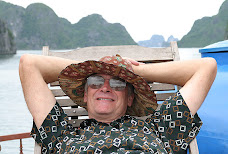Is the United States finally accepting responsibility for the devastating ongoing effects of Agent Orange in Vietnam, or is this funding just a way to get USAID in the door to meddle in the country’s affairs as part of Obama’s “Asian Pivot” strategy?
MintPress News investigates.
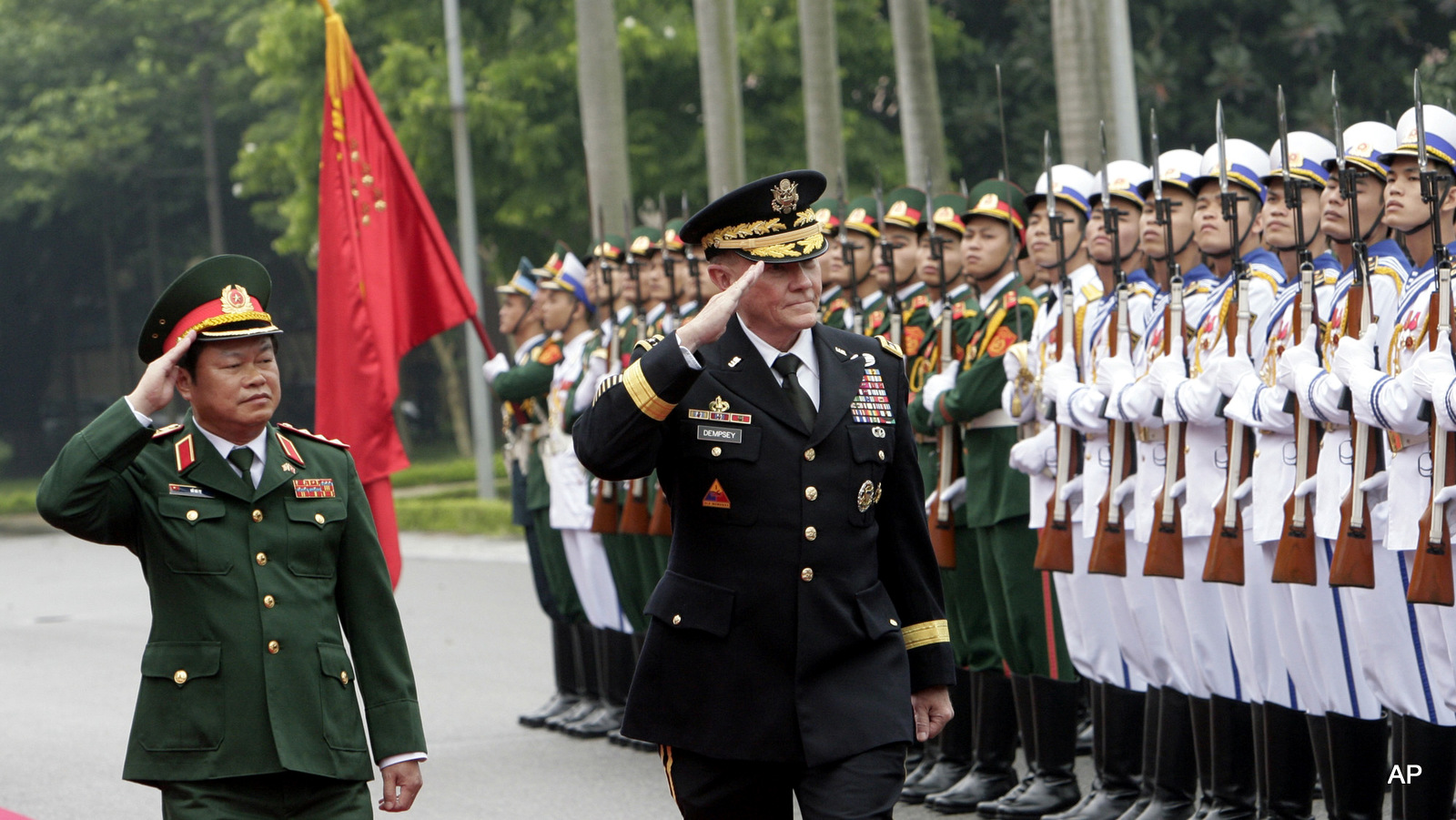 U.S. Chairman of the Joint Chiefs of Staff, Gen. Martin Dempsey, right, and Vietnamese Chief of General Staff of the Army, Lt. Gen. Do Ba Ty, left, during an honor guard review before their talks in Hanoi, Vietnam. The easing of an arms embargo against Vietnam and a military agreement with the Philippines show the Obama administration wants deeper security ties with Asia. On Thursday, Oct. 2, 2014, the State Department announced it would allow sales, on a case-by-case basis, of lethal equipment to help the maritime security of Vietnam, easing a ban that has been in place since communists took power at the end of the Vietnam War in 1975. Hanoi welcomed the step, saying it would promote the U.S.-Vietnam partnership.
U.S. Chairman of the Joint Chiefs of Staff, Gen. Martin Dempsey, right, and Vietnamese Chief of General Staff of the Army, Lt. Gen. Do Ba Ty, left, during an honor guard review before their talks in Hanoi, Vietnam. The easing of an arms embargo against Vietnam and a military agreement with the Philippines show the Obama administration wants deeper security ties with Asia. On Thursday, Oct. 2, 2014, the State Department announced it would allow sales, on a case-by-case basis, of lethal equipment to help the maritime security of Vietnam, easing a ban that has been in place since communists took power at the end of the Vietnam War in 1975. Hanoi welcomed the step, saying it would promote the U.S.-Vietnam partnership.
WASHINGTON — The use of Agent Orange constitutes a war crime with devastating effects on the people in Vietnam not only during the war but even today. The U.S. military knew that its use of Agent Orange would be damaging, but, as an Air Force scientist wrote to Congress, “because the material was to be used on the enemy, none of us were overly concerned.”
Ecocide was committed when “the U.S. military sprayed 79 million liters of herbicides and defoliants over about one-seventh of the land area of southern Vietnam.” The 2008-2009 President’s Cancer Panel Reportfound that nearly five million Vietnamese were exposed to Agent Orange, resulting in “400,000 deaths and disabilities and a half million children born with birth defects.”
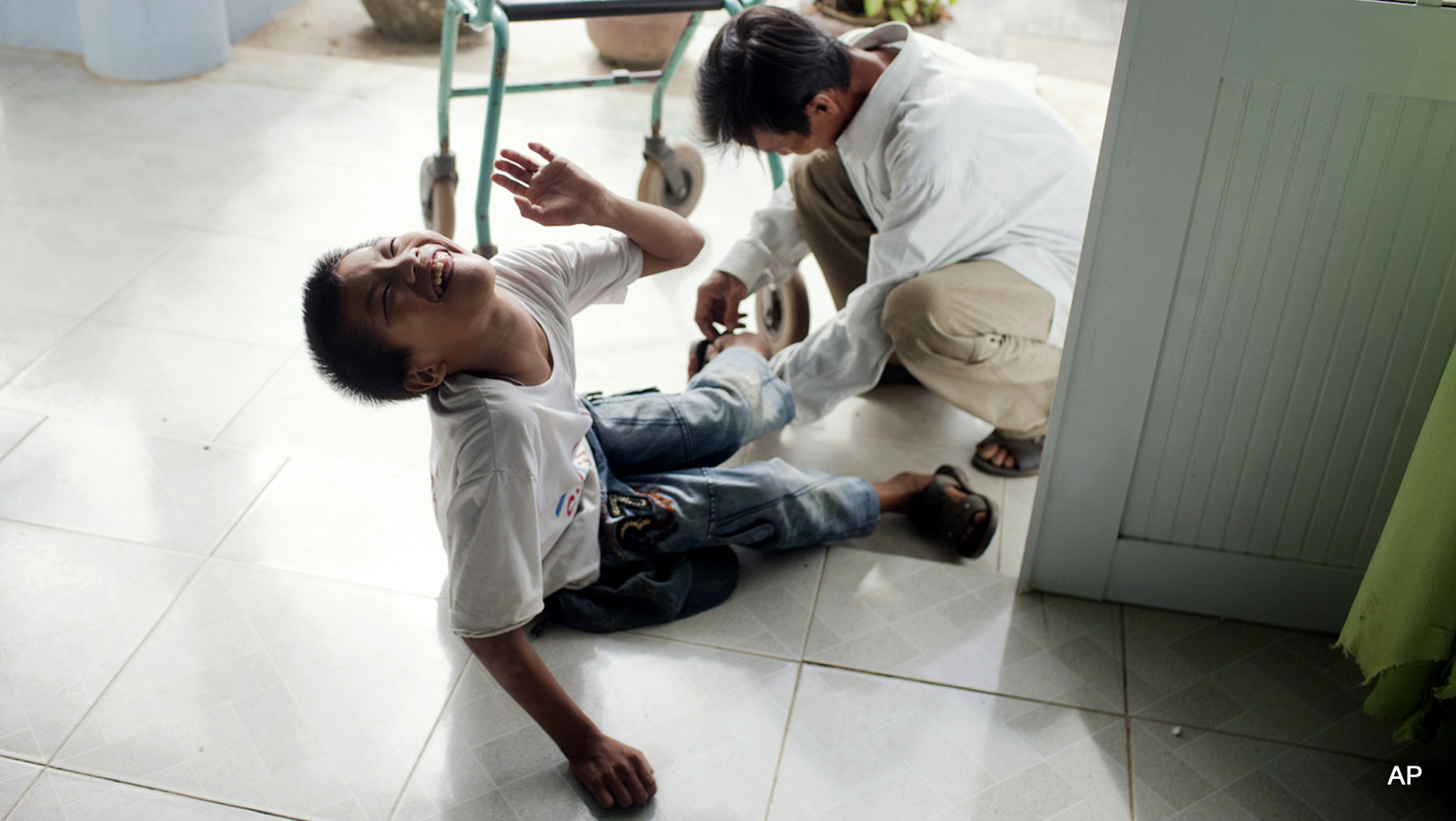
Le Van Tam, 14, is picked up by his father at a rehabilitation center in Danang, Vietnam. The children were born with physical and mental disabilities that the center’s director says were caused by their parents’ exposure to the chemical dioxin in the defoliant Agent Orange used by the U.S. military during the Vietnam war. Wednesday, Aug. 8, 2012.
No one has been held accountable for this crime. U.S. courts have blocked lawsuits brought by the people of Vietnam, and the United States has never paid adequate war reparations to assist in caring for the victims of Agent Orange or to clean up the environment.
In recent years, however, the U.S. has begun to fund cleanup and treatment programs for Agent Orange victims. The timing of this change in policy comes as the U.S. military has been building a relationship with the Vietnamese military as part of the so-called “Asian Pivot.” Yet this relationship has been impaired by the United States’ failure to properly deal with Agent Orange.
Funding for Agent Orange damages is being used to open the door to greater U.S. military involvement and influence in the region, but it will also allow an expansion of U.S. covert operations in Vietnam that set the stage for the U.S. to install a “friendlier” government, if necessary for U.S. hegemony in the region.
This funding is coming through the U.S. Agency for International Development (USAID), which has close ties to the CIA and a long history of covert intelligence and destabilization. Vietnam is experiencing a greater U.S. military presence along with USAID and the National Endowment for Democracy, also known for fomenting regime change.
Drawing Vietnam into US militarism
With its Asian Pivot, the U.S. intends to surround and isolate China by moving 60 percent of its Navy to the Asia-Pacific region, developing military agreements with countries there, and conducting joint military exercises with Pacific countries. The U.S. is also negotiating a massive corporate power-expanding treaty, the Trans-Pacific Partnership (TPP), which excludes China.
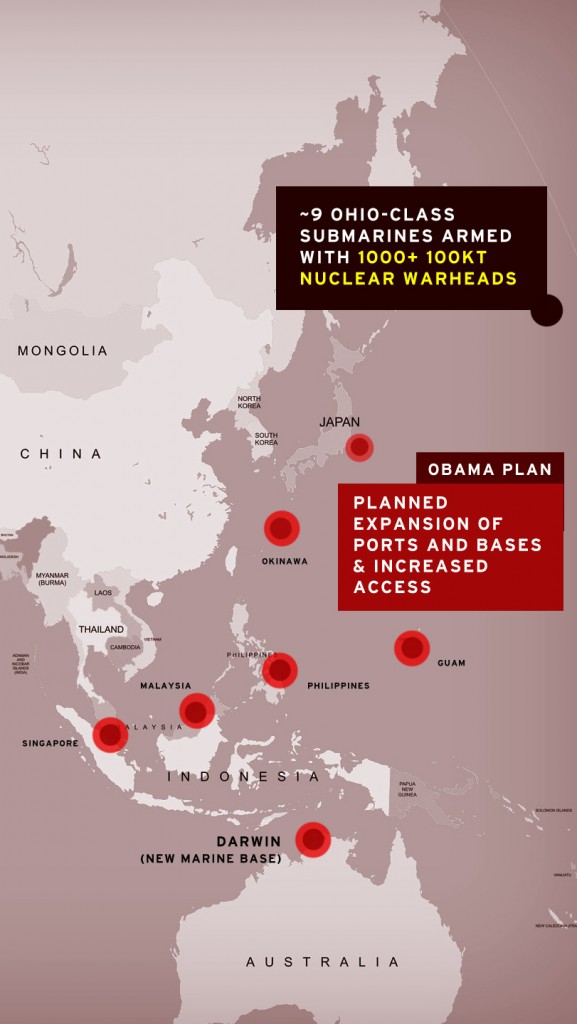
Map of current US military deployments in S.E. Asia. (Courtesy of the Schiller Institute, Inc. 2015. All Rights Reserved.)
Vietnam has been a focal point for the U.S. military since the end of the George W. Bush administration, a prelude to the Asian Pivot that was formally announced by President Obama. For the last five years, the U.S. and Vietnam have been involved in joint military exercises. The U.S. has also started to sell weapons to Vietnam, seeking to transition the Vietnamese from Russian weapons to American weapons. And there has been a series of high-level meetings between the two countries.
In June 2013, The Diplomat reported, “the Chairman of the U.S. Joint Chiefs of Staff hosted the first visit by the Chief of the General Staff of the Vietnam People’s Army (and Deputy Minister of National Defense), General Do Ba Ty. Ty’s delegation included the commander of Vietnam’s Air Force and the deputy commanders of the Navy and General Intelligence Department. His trip included a visit to the Joint Base Lewis-McChord in Washington state suggesting future possible joint activities.”
On July 25, 2013 Obama met with President Truong Tan Sang in Washington to form a U.S.-Vietnam Comprehensive Partnership, covering a range of concerns including war legacy and security issues. They agreed to cooperate militarily through the U.S.-Vietnam Defense Policy Dialogue and the bilateral Political, Security, and Defense dialogue to discuss future military cooperation.
That meeting was followed by two high-level meetings between the U.S. and Vietnamese militaries. On Oct. 1, 2013 they held the 6th U.S.-Vietnam Political, Security and Defense Dialogue. The U.S. delegation included representatives from the State Department, Defense Department, USAID and the U.S. Pacific Command, while the Vietnamese delegation included representatives from the foreign affairs, public security and national defense ministries. The agenda included counterterrorism, counternarcotics, human trafficking, cyber law enforcement, defense and security, disaster response, search and rescue, war legacy and cooperation in regional organizations.
On Oct. 28 to 29, 2013 a second meeting was held in Washington. The 4th U.S.-Vietnam Defense Policy Dialogue was a deputy minister-level meeting and involved officials from their respective defense ministries.The Diplomat reported that “both dialogues were held within the framework of the Memorandum of Understanding on Advancing Bilateral Defense Cooperation signed on September 19, 2011 and the U.S.-Vietnam Joint Statement of July 25, 2013.”
“What was new?” The Diplomat continued. “The two sides agreed to step up cooperation between their navies and their respective defense academies and institutions.”
Yet the Vietnamese are continuing to move slowly in building a military relationship with the U.S. Vietnam limits the U.S. Navy to one port call per year and continues to bar U.S. Navy warships from entry to Cam Ranh Bay. Further, Vietnam has yet to approve a request made by Defense Secretary Leon Panetta in June 2012 to set up an Office of Defense Cooperation in the U.S. Embassy in Hanoi.
A key factor holding back a closer military relationship is the inadequate cleanup of Agent Orange and the United States’ insufficient commitment to dealing with war legacies. After the 4th Defense Policy Dialogue, Vietnamese Deputy Defense Minister Nguyen Chi told Voice of Vietnam, “A better defense relationship should be based on the efficiency of practical cooperation, including overcoming [the] war aftermath… General speaking (sic), the U.S. has offered Vietnam active cooperation in the issue, but it is not enough as the consequences of war are terrible.”
Bloomberg reported last year on the fifth year of joint military operations, tying them to the Asian Pivot: “Two U.S. Navy ships began six days of non-combat exercises with the Vietnamese military as the U.S. seeks to bolster its presence in Asia at a time of growing tension between China and its neighbors.” Lt. Comm. Clay Doss, a Navy public affairs officer, described the evolution, saying: “The quality and depth of the exchanges is increasing each year as our navies get to know each other better.”
Chairman of the Joint Chiefs of Staff Martin Dempsey visited Vietnam in August – the first visit of a Joint Chiefs chairman since 1971. Dempsey’s trip came amid an escalation in conflicts between China and Vietnam. Among other things, he visited a U.S. military base where toxic defoliants had been stored.
In October, the U.S. eased a ban on lethal weapons sales to Vietnam. The U.S. said the arms sales would improve the maritime military capabilities of Vietnam so it could be more effective in conflicts in the Asia-Pacific region. In December 2013, Secretary of State John Kerry announced $18 million in assistance to Vietnam to provide its coast guard with five unarmed, high-speed patrol boats.
An October commentary in the People’s Daily, the flagship newspaper of China’s Communist Party, described these acts as destabilizing and “a clear extension of America’s interference with the balance of power in the region.” Maritime conflicts between Vietnam and China have been increasing as the U.S. adds military strength to Vietnam’s navy and coast guard. China maintains that disputes should be resolved through negotiations. Citing the Declaration of the Conduct of Parties in the South China Sea, the Chinese side maintains that “related countries should solve maritime disputes peacefully.”
Meanwhile, in Vietnam there are also concerns about an escalation of disputes: “Some senior Vietnam Communist Party leaders have worried over the years that moving to upgrade military-to-military ties with the US would provoke China to increase its pressure on Vietnam and its assertiveness in the South China Sea.”
In addition to challenging China, the U.S. also seeks to undermine the relationship between Vietnam and Russia. Russia, an arch rival of the U.S., has been the main weapons supplier for Vietnam since 2009. The U.S. wants to reorient Vietnam’s military away from Russia, which holds multi-billion dollar arms sales contracts with Vietnam, including the sale of submarines and fighter jets.
Sputnik, a Russian government-owned news media outlet, reported earlier this month that the U.S. “bullied” Vietnam to stop allowing Russia to use the Cam Ranh Bay naval base. The State Department says it has “urged Vietnamese officials to ensure that Russia is not able to use its access to Cam Ranh Bay to conduct activities that could raise tensions in the region.” Igor Korotchenko, director general of the Russian Center for Analysis of World Arms Trade, described the U.S. as stirring up tensions, instituting an arms race and creating regional instability.
Agent Orange funding a tool for US militarism — and what else?
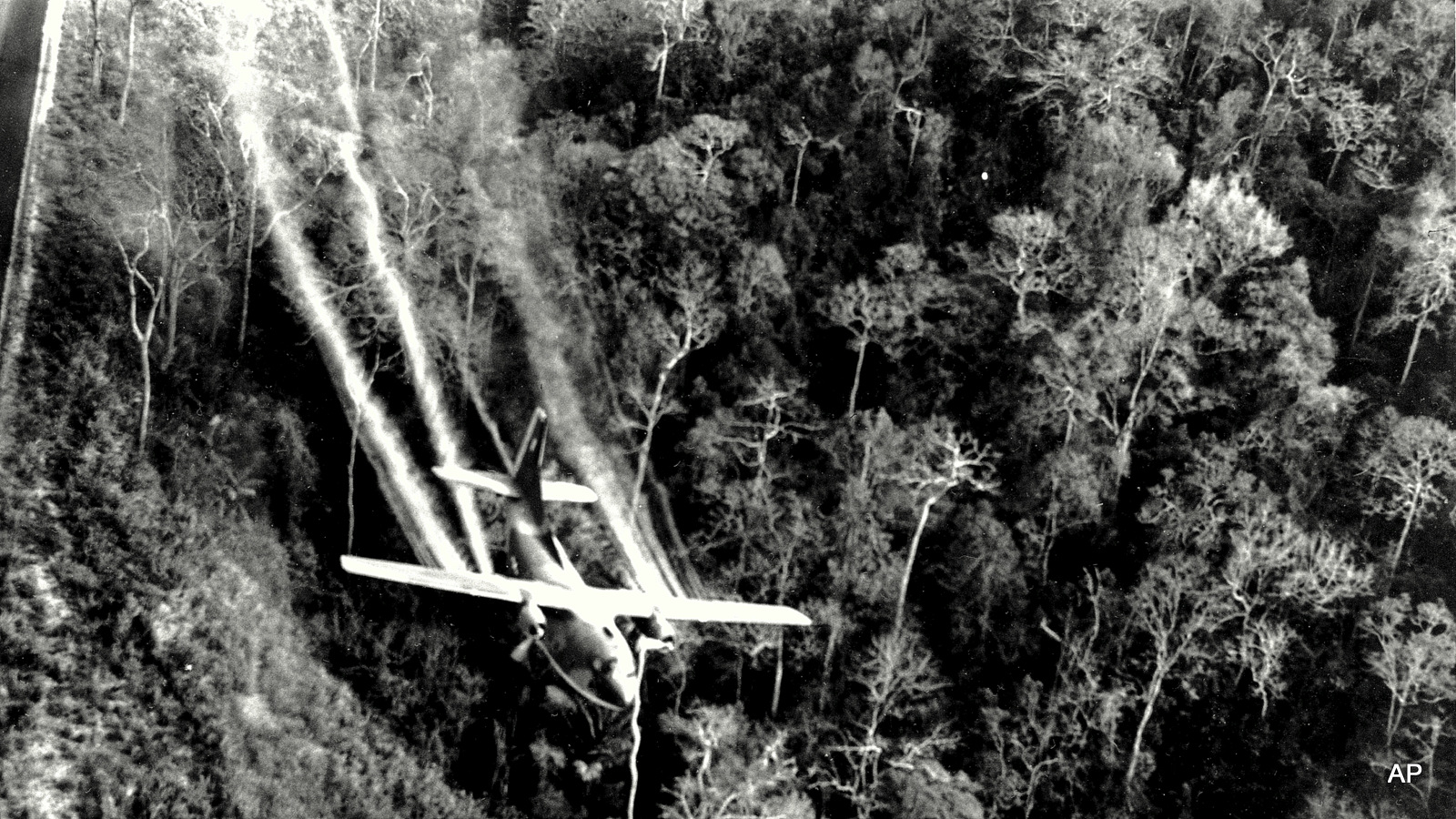 A U.S. Air Force C-123 flies low along a South Vietnamese highway spraying Agent Orange on dense jungle growth beside the road to eliminate ambush sites for the Viet Cong during the Vietnam War. During the Vietnam War, Air Force C-123 planes sprayed millions of gallons of herbicides over the jungles of Southeast Asia to destroy enemy crops and tree cover.
A U.S. Air Force C-123 flies low along a South Vietnamese highway spraying Agent Orange on dense jungle growth beside the road to eliminate ambush sites for the Viet Cong during the Vietnam War. During the Vietnam War, Air Force C-123 planes sprayed millions of gallons of herbicides over the jungles of Southeast Asia to destroy enemy crops and tree cover.
The Vietnamese government told the U.S. that one thing preventing a closer relationship between the U.S. and Vietnamese militaries is the failure of the U.S. to deal with the lasting effects of Agent Orange. After 50 years of the Agent Orange crisis the U.S. is finally beginning to fund some cleanup efforts. This funding is coming from USAID, which has a sordid history of serving as a cover for U.S. militarism and the CIA in Vietnam and around the world.
In William Blum’s 2004 book “Killing Hope,” John Gilligan, director of USAID under the Carter administration, describes the depth of the CIA-USAID relationship: “At one time, many AID [USAID] field offices were infiltrated from top to bottom with CIA people. The idea was to plant operatives in every kind of activity we had overseas, government, volunteer, religious, every kind.”
Likewise, The Washington Post reported in 2010 that, “In South Vietnam, the USAID provided cover for CIA operatives so widely that the two became almost synonymous.”
During the Vietnam War, USAID operated a police training program that was tied to death squads. Former New York Times correspondent A. J. Langguth wrote that “the two primary functions” of the USAID police training program were to allow the CIA to “plant men with local police in sensitive places around the world,” and bring to the U.S. “prime candidates for enrollment as CIA employees.”
The covert role of USAID has persisted. As The Washington Post reported in 2010, then-CIA Director Leon Panetta promised spies “new cover” for secret ops, and agencies that provide such cover include USAID and the State Department.
USAID has recently used health crises as cover for its covert operations. In 2011, Pakistan had a polio crisis, recording the highest number of polio cases in the world; it was a spiraling health catastrophe. USAID used a vaccination program organized by Save the Children, which had operated for 30 years in Pakistan, as cover to find Osama bin Laden.
The USAID-funded vaccination program used a Pakistani doctor and a local group, Lady Health Workers, to gain entrance to bin Laden’s home by going door-to-door to administer vaccinations. When vaccinations were administered to bin Laden’s children and grandchildren USAID tested the DNA of the used needles. It is likely that the doctor and two organizations were not aware they were being used by USAID. Save the Children staff members were expelled from Pakistan and the doctor was sentenced to 33 years in prison. His lawyer was murdered last week, and 74 health care workers have been killed since December 2012.
Last year, The Associated Press uncovered a USAID HIV-prevention program in Cuba used for covert operations. Beginning in October 2009, USAID, working through the Washington-based Creative Associates International, sent “Venezuelan, Costa Rican and Peruvian young people to Cuba in hopes of ginning up rebellion. The travelers worked undercover, often posing as tourists, and traveled around the island scouting for people they could turn into political activists.” They created an HIV-prevention workshop that “memos called ‘the perfect excuse’ for the program’s political goals.” Cuba uncovered the covert mission when the youth were questioned about their funding.
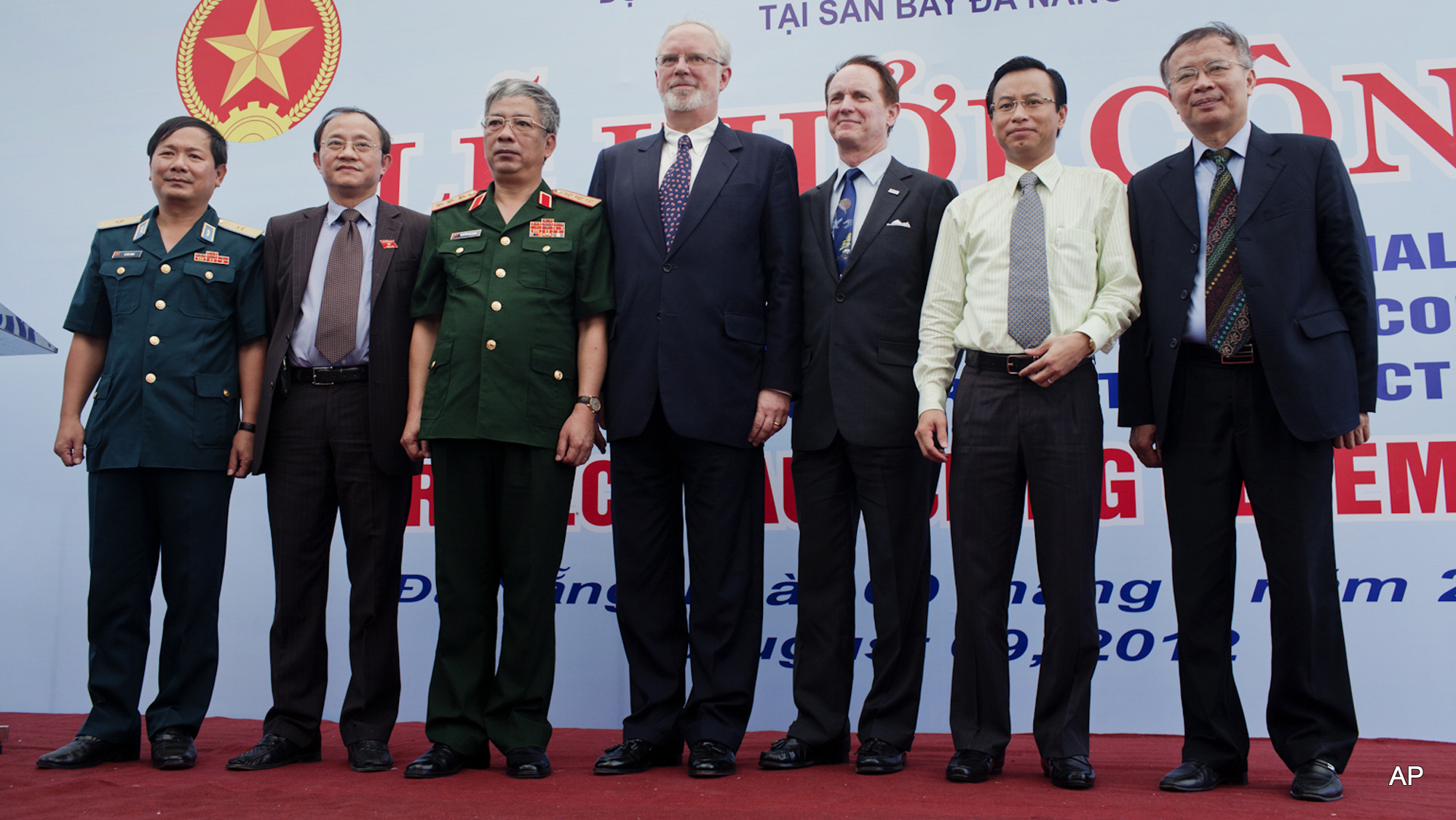 U.S. Ambassador to Vietnam David Shear, center, and Vietnam’s Deputy Defense Minister Nguyen Chi Vinh, third left, along with delegates, attend a ceremony marking the start of a project to clean up dioxin left over from the Vietnam War, at a former U.S. military base in Danang, Vietnam Thursday Aug. 9, 2012.
U.S. Ambassador to Vietnam David Shear, center, and Vietnam’s Deputy Defense Minister Nguyen Chi Vinh, third left, along with delegates, attend a ceremony marking the start of a project to clean up dioxin left over from the Vietnam War, at a former U.S. military base in Danang, Vietnam Thursday Aug. 9, 2012.
Noting that USAID has “a long history of engaging in intelligence work and meddling in the domestic politics of aid recipients,” Foreign Policy reported on another USAID program in Cuba, also exposed in 2014, where USAID covertly launched a social media platform in 2010, creating a Twitter-like service that would spark a “Cuban Spring.” The digital Bay of Pigs failed to spark a revolt, but it did expose the political leanings of 40,000 Cubans. This was reportedly not a CIA project, but a USAID project meant to undermine the Cuban government. Indeed, USAID has evolved to carry out its own meddling in the affairs of governments.
A 2006 State Department cable, released by WikiLeaks in 2013, outlined the United States’ strategy for undermining the Venezuelan government of Hugo Chávez by “Penetrating Chavez’ Political Base,” “Dividing Chavismo,” and “Isolating Chavez internationally.” The same office responsible for the digital Bay of Pigs in Cuba, USAID’s Office of Transition Initiatives, also carried out the program in Venezuela.
Bolivia expelled USAID in 2013 because it was meddling in Bolivian politics. President Evo Morales was upset that USAID money reached lowland regional governments that attempted to overthrow him in 2008. A Freedom of Information Act (FOIA) request showed that USAID provided “$10.5 million for ‘democracy-building’ awarded to Chemonics International in 2006 ‘to support improved governance in a changing political environment.’” (Democracy development is a common cover for programs to foment rebellion.)
Bolivia is one of the many countries that have recently expelled USAID over the organization’s meddling in internal politics. The Los Angeles Times reported in 2013 that “about 50 countries have adopted laws to limit foreign funding of civic groups or more strictly control their activities. About 30 other countries are considering restrictions.”
Meanwhile, U.S. covert actions in Vietnam have not ended. A blogger and lawyer who spent a year in the U.S. as a fellow the National Endowment for Democracy was arrested in December 2012 for pro-democracy activities. The National Endowment for Democracy has been providing hundreds of thousands of dollars to various Vietnamese projects related to changing the government in recent years. USAID has a major presence with 38 ongoing projects in Vietnam.
It may be that regime change activities are already beginning in Vietnam. In 2014, there were large anti-China protests and attacks on Chinese businesses in Vietnam. Some speculated that the Vietnamese government was behind the protests, but David Koh, a reporter for Singapore’s Straits Times, who works with NGOs in Vietnam, interviewed officials and businessmen in Vietnam and reported that the government was surprised by the protests.
The protests were also against economic conditions and other issues in Vietnam, and it remains unclear who planned and funded the events. Researchers in Singapore who interviewed people on the ground in Vietnam wrote:
“A large number of Vietnamese flags and T-shirts had been purchased before the demonstrations suggesting that the attacks were not spontaneous. Even maps locating Chinese and Taiwanese factories had been photocopied in large numbers. The leaders of the riots have been reported to have been using walkie-talkies to communicate with each other. The fact that the violence affected as many as 200 factories in a single day already suggests that a high level of professionalism and organization was involved. This suggests that the riots were premeditated, although unlike the earlier peaceful demonstration of the patriots, they were not announced openly. Workers were believed to receive from VND50,000 to VND300,000 VND (equivalent to US$2.3 to US$14) to follow the agitators. This begs the question: where did the money come from?”
It’s important to note that people were paid more than a day’s labor to participate.
The Singapore researchers ultimately concluded that the Vietnamese government was the big loser:
“However, for now, the notion that the riots and violence were simply the result of a wave of blind nationalism and anti-Chinese sentiments must be re-examined. The current crisis presents major challenges for not only Vietnam-China relations, regional stability and ASEAN’s unity, but most of all, for Vietnam’s political system.”
Agent Orange Trojan Horse compounds war crimes
In addition to opening up Vietnam to a deeper relationship with the U.S. military – which is dangerous enough for Vietnam, China, Russia and the broader Asia-Pacific region – what else will USAID do with its foothold in Vietnam? As USAID so routinely involves itself in the affairs of foreign governments, it would be foolish to assume that USAID does not have other plans for Vietnam.
Rather than paying war reparations, the U.S. is using Agent Orange as a Trojan Horse to further U.S. militarization in Vietnam, escalate conflict with China and break the Vietnamese relationship with Russia. It may also be laying the groundwork for regime change if Vietnam does not comply as a tool of U.S. empire.
Vietnam should continue to demand war reparations that are adequate for the problems the U.S. created and keep the U.S. military at arm’s length. Vietnam should kick out USAID and the National Endowment for Democracy, and demand that payments be made directly to Vietnam to keep U.S. meddling out of their country. Indeed, the U.S. should not be allowed to leverage the war crime of its use of Agent Orange as a tool for more U.S. militarism and intervention.
Link to original article and comments:

